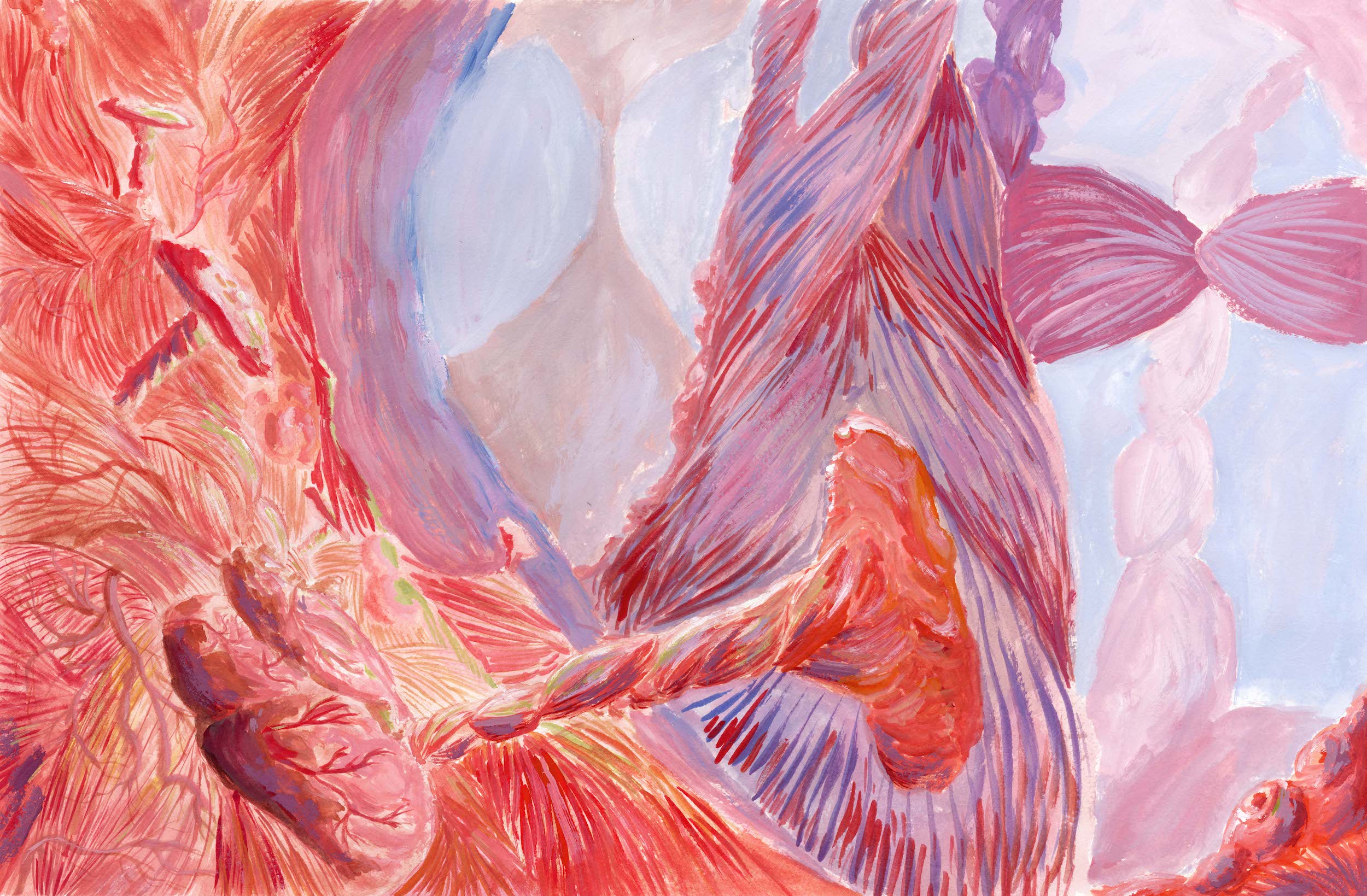 Maths, Physics & Chemistry
Maths, Physics & Chemistry
Cellular tornadoes and how they shape our organs
During development our organs take different distinct shapes. Recent results from our lab showed that under certain circumstances muscle cells collectively spiral and rotate to protrude and self-organize in 3D to form “cellular tornadoes”.

Illustration realized in the framework of a collaboration between the Image/Recit option of the HEAD (Haute École d'Art et de Design) - Genève and the Faculty of Sciences of the University of Geneva.
During growth and development, cells are known to self-organize to give rise to various shapes that define our organs. But how are the forces that drive this cell organization generated? Biochemists from our lab worked with physicists from the lab of Prof. Kruse to attempt to answer this, in this recent study, where the authors describe that muscle cells behave like semi-solid matter to self-organize in 3D over time.
The researchers designed a clever model to mimic muscle-like organization occurring in mammals. In the lab, they grew immature muscle cells that have not yet differentiated into adult muscle cells. The scientists grew these on a sticky disc-shaped surface where the cells can attach to and divide. In this system, they can easily follow the organization of these dividing cells with a microscope. They then observed the first steps of these progenitor muscle cells coming together and maturing to form muscle.
Initially, the sparse muscle cells divide to cover the entire surface of the disc. Once they cover the entire surface of the disc they start to collectively spiral around the edges of the disc. Over time the scientists observe that when these collectively spiraling muscle cells increase in number they stop spiraling and change their path. They now begin to accumulate in the center, creating an asterisk-like shape with their movement. This movement of cells creates an accumulation of cells in the center, like a mound of cells, ever growing in 3D.
The plot thickens when the cells in the mound start to spiral again like a tornado to push the cellular mound to a more prominent 3D protrusion. These fascinating tornado-like protrusions are more than a quarter of a millimeter in length: large enough to accommodate several layers of cells. This is evident in the beautiful images of the cellular protrusions gathering neighboring cells upwards to further create a tornado. What is even more captivating is the cells in the 3D protrusion grow in a spiraling fashion, resembling a spiral staircase. This spiraling behavior gives them their “cellular tornado” name.
The researchers show that the way these muscle cells organize over the length of the protrusion follows the physical behaviour of liquid crystals. A liquid crystal is a material which has both liquid and solid nature. For example, a liquid crystal may flow like a liquid (its individual particles do not have a fixed position) but its particles have an orientation like a solid. Some regions of the liquid crystal lose this orientation order and disordered regions are formed. Asterisks and spirals are regions of loss of order with singularities i.e regions where the particles are orientated towards a central point.
The scientists saw that these asterisk and spiral patterns found in liquid crystals also dictate the organization of muscle cells. This result is extremely exciting as it suggests that biological systems also have to abide by physical laws.
Original Article:
Guillamat, P., Blanch-Mercader, C., Pernollet, G., Kruse, K. & Roux, A. Integer topological defects organize stresses driving tissue morphogenesis. Nature Materials (2022). doi:10.1038/s41563-022-01194-5Edited by:
Zoé Valbret , Senior Scientific Editor
We thought you might like
Carnivorous plants help uncover universal rules of plant development
Aug 14, 2020 in Plant Biology | 4 min read by Beatriz Gonçalves , Christopher WhitewoodsDe-liver-ing blood and immune cells to the developing human
Aug 25, 2020 in Health & Physiology | 3 min read by Emily Stephenson , Laura JardineAre you going places? Mapping unequal access to services and opportunities worldwide
Apr 8, 2021 in Earth & Space | 3.5 min read by Andrea CattaneoMore from Maths, Physics & Chemistry
Testing gravity through the distortion of time
Sep 20, 2024 in Maths, Physics & Chemistry | 3 min read by Sveva CastelloStacking molecular chips in multiple dimensions
Aug 30, 2024 in Maths, Physics & Chemistry | 3 min read by Lucía Gallego , Romain Jamagne , Michel RickhausReversible Anticoagulants: Inspired by Nature, Designed for Safety
Jun 12, 2024 in Maths, Physics & Chemistry | 4 min read by Millicent Dockerill , Nicolas WinssingerDistance-preserving moves always keep a point fixed
May 18, 2024 in Maths, Physics & Chemistry | 4 min read by Shaula FiorelliA resonance triggers chemical reactions between the coldest molecules
Apr 5, 2024 in Maths, Physics & Chemistry | 3 min read by Juliana Park , Wonyl ChoiEditor's picks
Trending now
Popular topics


